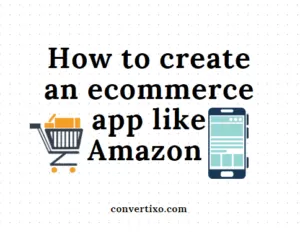How to create an ecommerce app like Amazon
Introduction
Have you Ever considered operating an Online Business by your own virtual shops, that is filled with customers who peruse your offerings, Gather items into their virtual shopping carts, and click the irresistible “BUY NOW” button? It sounds quite great, doesn’t it? But wait, before you begin to imagine your online business, let’s discuss something really important: creating your ecommerce app. We’re talking about building an online platform that can compete with the major companies, like Amazon, not just any old website. We will go over every aspect of creating your own e-commerce website from the start in this blog. Consider it your roadmap to realizing your aspirations in e-commerce. We’ll go over everything, from comprehending your target market to creating an amazing user experience for your clients. History
Amazon, which was first established in 1994 as an online bookshop by Jeff Bezos, quickly grew to become the biggest e-commerce site globally. Amazon revolutionized online shopping by using growing internet technology and customer-centric strategies to expand its offers and include a wide range of products. Its expansion was driven by providing excellent customer service, innovative offerings like Amazon Prime, and smart. Amazon is a massive force in the e-commerce sector today, influencing customer behavior and establishing new benchmarks for online shopping.
History
Amazon, which was first established in 1994 as an online bookshop by Jeff Bezos, quickly grew to become the biggest e-commerce site globally. Amazon revolutionized online shopping by using growing internet technology and customer-centric strategies to expand its offers and include a wide range of products. Its expansion was driven by providing excellent customer service, innovative offerings like Amazon Prime, and smart. Amazon is a massive force in the e-commerce sector today, influencing customer behavior and establishing new benchmarks for online shopping.
7 steps to make your own ecommerce website from scratch
-
Proper strategy and market research
-
Strategizing Features and Design
- User authentication and security
- Search and filters
- Add to Cart/wishlist options
- Order tracking
- Easy payment methods(UPI, debit card, credit cards)
- Discounts and Referral offers
- Reviews, ratings & feedback
- Pushup notifications
- Allow different languages for app
- Customer support and helplines numbers
UI and UX
Creating wireframes and mockups to visualise the user interface (UI) and user experience (UX) design, ensuring a smooth and intuitive navigation flow throughout the app. Design considerations should encompass elements such as intuitive product categorization, clear call-to-action buttons, visually appealing product listings, and streamlined checkout processes. By meticulously planning the app’s features and design early on, you lay a solid foundation for the development phase and enhance the likelihood of creating a user-friendly and engaging ecommerce experience.-
Front end development
-How to Learn Frontend Development?
- Learn HTML(for structure of website)
- CSS(For designing and styling)
- Learn css framework(bootstrap or flexbox) for creating layout and js frameworks(React, angular or vue.js) for interactive UI
- Use online resources and practice on leetcode.
-
Backend development
-How to Learn Backend Development:
- Select a programming language (Java, Python, etc.).
- Learn web frameworks (Django and Express.js).
- Understand databases (MySQL, MongoDB)and APIs
- Take online resources from internet
-
Estimate the cost of development
-
Testing the App
-
Promoting and Publishing the app
- App optimization: Increase your app’s visibility in app store searches and bring in new users, make sure the app’s title, outline, search terms, and images are optimized.
- Collaborations: To increase your reach and pull new clients, work with influencers, brands, or businesses that compliment each other by organizing joint events, co-branded campaigns, or cross-promotions.
- Use paid advertising and social media marketing on sites like Facebook, Instagram, Twitter, and Google Ads to promote your products, interact with customers, and send relevant traffic to your e-commerce app.
- Get Your App Ready: Make sure that your e-commerce app development is finished, tested, and prepared for distribution. Fix any issues, enhance performance, and complete features.
- Create account: Sign up for developer accounts on the app shops (like Google Play Store or Apple App Store) where you want to release your app.
- Submit your application and Wait for Approval: Send in your application for the app store team to review. Your app will be downloaded by the general public after it has been approved. To give users the greatest experience possible, update and maintain your app frequently.
